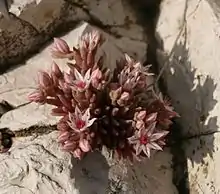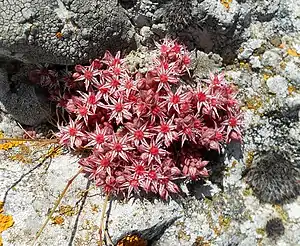Sedum hispanicum
Sedum hispanicum, the Spanish stonecrop,[1] is a species of plant in the family Crassulaceae.
| Sedum hispanicum | |
|---|---|
 | |
| Scientific classification | |
| Kingdom: | Plantae |
| Clade: | Tracheophytes |
| Clade: | Angiosperms |
| Clade: | Eudicots |
| Order: | Saxifragales |
| Family: | Crassulaceae |
| Genus: | Sedum |
| Species: | S. hispanicum |
| Binomial name | |
| Sedum hispanicum L. | |
Description
Annual, 5–15 cm, glabrous or somewhat pubescent. Stems branching. Leaves alternate, 7–10 mm, linear, rounded. Flowers usually 6-merous, sometimes 7-9-merous, in unilateral cymes. Sepals ovate-acute. Petals white, with a purple midrib, 5–7 mm, lanceolate, acuminate. Carpels stellate.
Flowering
March–June.
Habitat
Rocks.
Distribution

Coast, lower, middle and upper mountains, Beqaa, Antilebanon.
Geographic area
Syria, Lebanon, the Palestine region, Western Asia, the Balkans, Italy, and Switzerland.
Notwithstanding its specific name this stonecrop is not found in Spain. Sedum is the Latin name of the adjoining genus, Sempervivum, houseleek. It is derived from sedare, to appease, to tranquillize, since the houseleek cultivated on housetops was supposed to take away the thunder, or probably because the crushed leaves used in plasters have a sedative action.[2]
References
- "Sedum hispanicum". Natural Resources Conservation Service PLANTS Database. USDA. Retrieved 20 December 2016.
- Mustapha Nehmeh, Wild Flowers Of Lebanon, National Council For Scientific Research,1978,pages 175,176.
- Georges Tohme& Henriette Tohme, IIIustrated Flora of Lebanon, National Council For Scientific Research, Second Edition 2014.